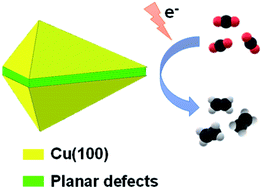Planar defect-driven electrocatalysis of CO2-to-C2H4 conversion†
Abstract
The selectivity towards a specific C2+ product, such as ethylene (C2H4), is sensitive to the surface structure of copper (Cu) catalysts in carbon dioxide (CO2) electro-reduction. The fundamental understanding of such sensitivity can guide the development of advanced electrocatalysts, although it remains challenging at the atomic level. Here we demonstrated that planar defects, such as stacking faults, could drive the electrocatalysis of CO2-to-C2H4 conversion with higher selectivity and productivity than Cu(100) facets in the intermediate potential region (−0.50 ∼ −0.65 V vs. RHE). The unique right bipyramidal Cu nanocrystals containing a combination of (100) facets and a set of parallel planar defects delivered 67% faradaic efficiency (FE) for C2H4 and a partial current density of 217 mA cm−2 at −0.63 V vs. RHE. In contrast, Cu nanocubes with exclusive (100) facets exhibited only 46% FE for C2H4 and a partial current density of 87 mA cm−2 at an identical potential. Both ex situ CO temperature-programmed desorption and in situ Raman spectroscopy analysis implied that the stronger *CO adsorption on planar defect sites facilitates CO generation kinetics, which contributes to a higher surface coverage of *CO and in turn an enhanced reaction rate of C–C coupling towards C2+ products, especially C2H4.

- This article is part of the themed collection: Journal of Materials Chemistry A Emerging Investigators


 Please wait while we load your content...
Please wait while we load your content...